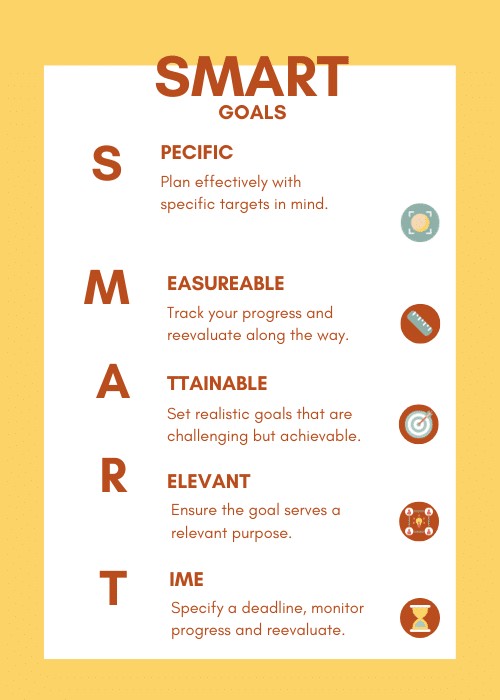SMART Nutrition Goals for Weight Loss in Menopausal Women
Are you frustrated in your weight loss journey now that you’ve entered menopause? You’re definitely not alone. Many women struggle to lose weight during this stage of life due to hormonal changes, slower metabolism, and other factors. However, with the right nutrition, you can still achieve your desired weight.
Table of Contents
ToggleSMART nutrition goals can help you successfully achieve and maintain a healthy weight. In this blog post, I will discuss the strategies I use with my clients for setting and achieving smart nutrition goals for weight loss.
What are Smart Goals?
Smart goals are specific, measurable, achievable, relevant, and time-bound objectives that help people focus on their desired results.
These goals provide structure and motivation as they focus on the desired outcome and set a timeline for achieving it.
Let’s go into more detail and define each one of the components of SMART goals.

Specific
Set clear, specific goals on what you want to achieve with your diet changes. Identify the nutrients your body needs and which foods you should eat.
Measurable
Establish measurable goals to track your progress and motivate yourself to stay on track. What goals do you want to track? How will you track them? What progress do you hope to see?
Achievable
Ensure your goals are achievable and realistic. Don’t try to make significant dietary changes overnight or aim to lose weight too fast. Instead, make small, gradual changes to your diet and lifestyle habits that you can sustain over the long term.
Relevant
Set goals that are relevant to your goals and needs.
Time-bound
Set a timeline for achieving your goals. Is this goal short-term or long-term? Is it part of a bigger goal? Whatever your timeline looks like, aim to improve your diet over several weeks or months gradually.
SMART Nutrition Goals for Weight Loss in Menopause
Balance Your Macronutrients
The menopausal period often comes with changes in body composition, including a tendency to store more fat around the abdomen. To address this, focus on a balanced macronutrient intake. This means including a good ratio of carbohydrates, proteins, and fats in your daily diet.
Example of a SMART goal:
I will create balanced meals following the MyPlate guidelines, ensuring that half of my plate is filled with vegetables and fruits, one-quarter with lean protein sources, and one-quarter with whole grains. I will follow this plan for at least two meals a day over a period of one month.
As you can see, this goal is:
Specific: you know exactly what to do.
Measurable: you can see the composition of your plate.
Achievable: following MyPlate guidelines does not require drastic changes in your diet.
Realistic: it’s a balanced approach, including all food groups.
Timely: one month is an appropriate time frame to see results without feeling too overwhelming.
Add Protein to Breakfast
Adding protein to your mornings can help balance blood sugar levels throughout the day and reduce cravings. This is especially important during menopause, when insulin resistance may be a factor in weight gain.
Example of a SMART goal:
I will add one serving of protein (such as eggs, Greek yogurt, or nut butter) to my breakfast every morning for two weeks.
This goal is:
Specific: you know exactly what to do and what foods to incorporate.
Measurable: you can track if you are adding protein to your breakfast every morning for two weeks.
Achievable: adding one serving of protein is a simple and feasible change to make in your daily routine.
Realistic: this goal focuses on adding more nutrients to your diet, rather than restricting or eliminating certain foods.
Timely: two weeks is an appropriate time frame.
Eat Less Sugar
Decreasing sugar intake during menopause can aid in weight loss by stabilizing blood sugar levels, controlling appetite, promoting healthier fat distribution, and improving insulin sensitivity, ultimately supporting overall health and weight management.
Example of a SMART goal:
I will eliminate sugary beverages from my daily diet, including soda, sweetened iced tea, and fruit juices. I will replace sugary beverages with healthier alternatives such as water, herbal tea, and unsweetened sparkling water. I will follow this plan for at least one month to reduce my sugar intake and improve my overall health.
As you can see, this goal is:
Specific: it clearly states which sugary beverages should be eliminated and replaced.
Measurable: you can track your progress by monitoring the types of drinks you consume daily.
Achievable: eliminating only one type of added sugar and finding replacements is a manageable approach.
Realistic: it is possible to eliminate sugary beverages.
Timely: one month is a reasonable time frame to see the effects of reducing drinks high in sugar.
Helpful blog posts:
Will Cutting Out Soda Make You Lose Weight?
A bonus side effect of this goal: achieving it can also help you manage blood sugar, which in turn can help reduce hot flashes.
Eat Mindfully
Mindful eating is a practice that involves paying attention to your food, savoring each bite, and being aware of your body’s hunger and fullness signals. This can help you make more conscious food choices and prevent overeating.
Example of a SMART goal:
I will practice mindful eating at least three times a week by sitting down at a table without distractions and fully concentrating on and enjoying my meal.
As you can see, this goal is:
Specific: it outlines the specific actions involved in practicing mindful eating.
Measurable: you can track your progress by monitoring how many times a week you practice mindful eating.
Achievable: committing to three times a week is a manageable starting point for incorporating mindful eating into your routine.
Realistic: practicing mindful eating supports making conscious food choices and preventing overeating, which can contribute to overall health goals.
Timely: setting a goal of at least three times a week allows for gradual progress and consistency.
Helpful blog posts:
Mindful Eating: Your Checklist for Weight Loss
Making Better Choices at Restaurants
Eating out is a common part of our lives, and it can be challenging to make healthy choices at restaurants.
However, nowadays, many restaurants offer lighter options, and nutrition information is readily available for various restaurant chains. By identifying lower-calorie and healthy meals beforehand, you can stick to your goals when eating out.
Example of a SMART goal:
This weekend, take the time to identify 10 low-calorie meals that you can enjoy in the restaurants you visit. Start a list on your phone and use it as a reference when dining out.
Specific: the goal specifies a clear action — identifying 10 low-calorie meals for restaurant dining.
Measurable: the goal includes a specific number (10) of low-calorie meals to identify, making it easy to track progress.
Achievable: it’s a realistic goal as it’s feasible to research and list 10 low-calorie restaurant meals.
Relevant: the goal is relevant to the broader context of managing nutrition and making healthier choices when dining out.
Time-Bound: it sets a timeframe (this weekend) for completing the task, creating a sense of urgency and ensuring the goal is achieved within a defined time period.
Why I Like Setting SMART Goals
Setting SMART (Specific, Measurable, Achievable, Realistic, Timely) goals is an effective way to reach your weight loss ambitions. By following this framework, you can set clear and actionable objectives that lead to success.
Some reasons why I like setting SMART goals are:
- Clarity: With the specific criteria involved in setting SMART goals, it becomes easier to understand exactly what you’re aiming for. This clarity enables you to focus on the necessary steps to achieve your goals.
- Accountability: By setting measurable goals, it becomes easier to track progress and hold yourself accountable for your actions. This accountability can motivate you to continue working towards your goals.
- Realistic: As mentioned earlier, incorporating realistic elements into your goal-setting process helps to ensure that your ambitions are attainable. This approach prevents setting unachievable objectives that may lead to disappointment and frustration.
- Time-bound: By setting a timeframe for achieving your goals, you create a sense of urgency and avoid procrastination. Additionally, having a deadline can help you stay motivated and on track towards reaching your target.
- Eliminates decision fatigue: When you have a clear plan and specific goals, it becomes easier to make decisions that align with your objectives. This eliminates decision fatigue and prevents impulsively making unhealthy choices.
- Builds confidence: By setting achievable and measurable goals, you can track your progress and celebrate small wins along the way. These accomplishments can boost your self-confidence and keep you motivated to continue working towards your larger plan.
In addition to these reasons, setting SMART goals also allows for adaptability. As circumstances may change, you can reassess and adjust your goals accordingly while still maintaining the overall direction towards success. This flexibility helps to prevent feeling overwhelmed or discouraged if obstacles arise along the way.
The Bottom Line
Remember to keep your goals specific, measurable, achievable, relevant, and time-bound.
It’s important to consult a registered dietitian for personalized dietary recommendations, stay physically active, and use supplements and medications, if necessary.
With proper diet and lifestyle changes, women can control menopausal symptoms, prevent age-related diseases, and improve their overall health and well-being.

Dr. Su-Nui Escobar, a Registered Dietitian/Nutritionist in Miami, FL, is dedicated to empowering women in perimenopause and menopause to live healthier, more satisfying lives.
With a doctorate in clinical nutrition from the University of North Florida, she has expertise in menopause and weight loss, including the unique challenges faced by those on weight loss medications.
Su-Nui’s passion for her field is evident in her previous role as the Academy of Nutrition and Dietetics spokesperson.


